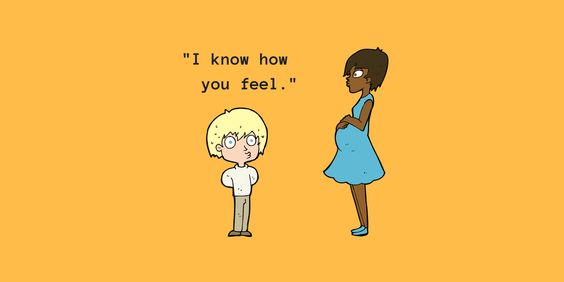Empathy is the capacity to understand or feel what another person is experiencing from within their frame of reference, that is, the capacity to place oneself in another’s position.

“It’s incredibly difficult to show empathy to people you really don’t know. And interviewing them for an hour and giving them an Amazon gift card doesn’t constitute knowing them.
It’s also difficult to show empathy for someone who “isn’t a part of your tribe” who doesn’t look like you or act like you. This is why you have to engineer empathy. And why you need diverse design teams to do it.” – Stop Bastardizing Design with False Empathy.
When you can empathize with me, you feel what I’m feeling within my frame of reference. When you and I have that deep understanding, what is the purpose of a conversation, design thinking project, brainstorming, or teamwork?
Stating that you are starting with empathy is like sending thoughts and prayers.

“… rather than saying that misunderstandings are ‘inherent in conversation,’ our view is that misunderstandings constitute conversations and that misunderstandings make conversation possible. If we simply (radically) understand each other, we would have nothing to talk about.” – Steve de Shazer – Making Numbers talk.
I find empathy difficult (my wife often says I have little empathy). And as a white 44-year male with many privileges, I cannot comprehend how I can empathize with someone whose life experience differs from mine.
In my 20s, I was an educator of at-risk and adjudicated youth for Clemson University (we ran alternative schools and some partnerships with the Dept of Justice for youth). Hearing their stories and meeting the families, I never felt empathy. I cognitively could not imagine or feel what they were going through or “put myself in their shoes.” Also, if I could put myself in their shoes, it would still not be their experience; it would be my experience in their shoes.
Empathy has always felt like a vapid response that marketers and inept leadership fabricate to behave as if they are not trying to manipulate, influence, or convince you to buy something.
Your empathy can be helpful and not necessary.
In some cases, empathy takes the other person’s focus and brings it to you. When empathy is on how you handled or felt during a similar situation, you are not respecting the person and their views. You are emotionally hijacking their story to show your understanding, disrespecting their personhood and lived experience.
Solution-focused (SOLVEDcards) work focuses on the person, their words, and their truth. I have no business in their shoes, not my interpretation or empathy of their truth. Listening and deeply respecting their agency and lived life in their experience.
With solution-focus, we focus on the language listening for description elements of progress, what’s better, indicators of how they are strong or learned through their experience. We listen for descriptions to reflect on the person (their words) instead of empathizing and hijacking the person with our lived experience.
In place of empathy, accept the conversation as all there is, and there is nothing behind or beneath the conversation. “In the conversation, look to notice differences so that these noticed differences can be put to work. Then the noticed differences can make a difference.” – Steve de Shazer.

